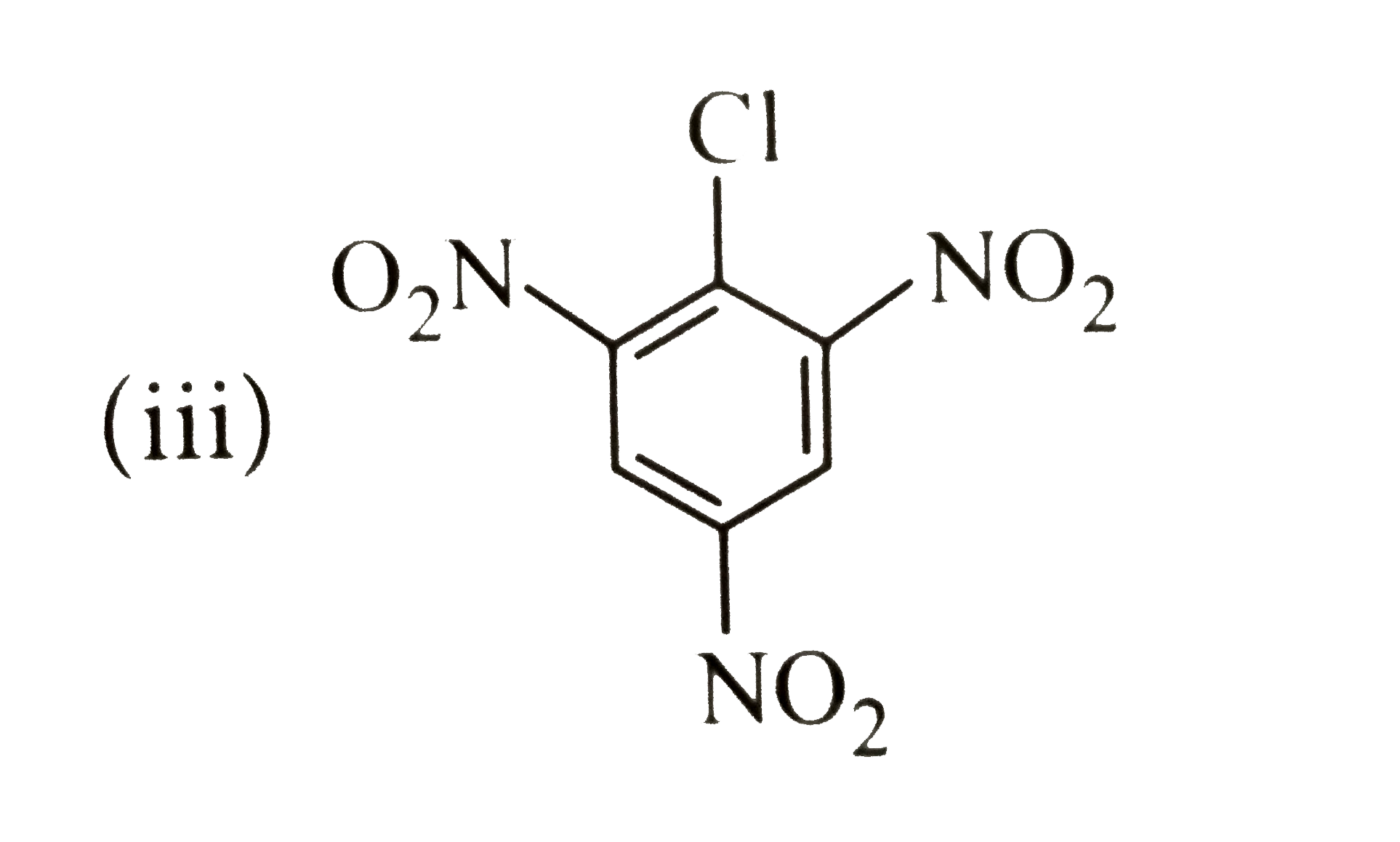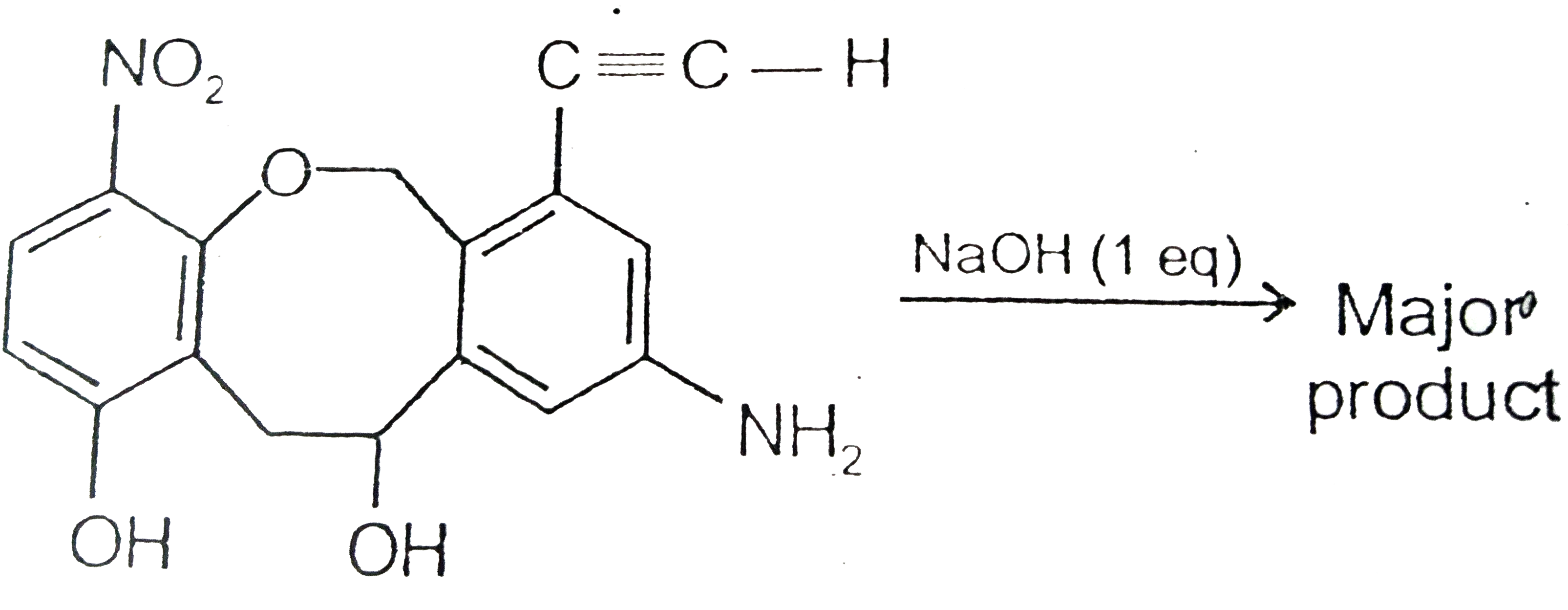Chlorobenzene can be converted into phenol by heating in aqueous sodium hydroxide solution at temperature of 623K and a pressure of 300atm. However the rate of reaction can be increased by presence of certain groups in benzene ring. What will be the order of reactivity of following compounds towards the above substitution reaction?


(iii)gt(ii)gt(i)
(ii)gt(iii)gt(i)
(i)gt(ii)gt(iii)
(i0gt(iii)gt(ii)
The correct Answer is:A
The presence of an electron withdrawing group (−NO2) at ortho and para -positions increases the reactivity fo haloarenes.
Similar Questions
Free enegry , G=H−TS, is state function that indicates whther a reaction is spontaneous or non-spontaneous. If you think of TS as the part of the system's enegry that is disordered already, then (H−TS) is the part of the system's energy that is still ordered and therefore free to cause spontaneous change by becoming disordered.
Also, ΔG=ΔH−TΔS From the second law of thermodynamics, a reaction is spontaneous if ΔtotalS is positive, non-spontaneous if ΔtotalS is negative, and at equilibrium if Δ'→talS is zero.
Since, −TΔS=ΔG and since ΔG and ΔS have opposite sings, we can restate the thermodynamic criterion for the spontaneity of a reaction carried out a constant temperature and pressure.
IF ΔG<0, the reaction is spontaneous.
If ΔG>0, the reaction is non-spontaneous.
If ΔG=0, the reaction is at equilibrium.
Read the above paragraph carefully and answer the following questions based on the above comprehension.
One mole of ice si converted to liquid at 273K,H2O(s) and H2O(l) have entropies 38.20 and 60.03Jmol−1dg−1. Enthalpy change in the conversion will be
View SolutionGive the decreasing order of the relative reactivity towards SE reaction of the following compounds.
a. I. Benzene, II. Phenol, III. Aniline, IV. Chlorobenzene
View SolutionThe typical reaction of benzene and other aromatic compounds are electrophilic substitution. Presence of electron donating group activates the ring towards electrophilic substitution, while presence of electron withdrawing group deactivates the ring towards electrophilic substituion but at the same time activates the ring towards nucleophilic subsituion. Some groups are predominantly meta-directing and all of these are deactivating. Except halogen, most of the o−andp−directing groups are activating groups.
Which of the following compound is not formed.
_E01_248_Q01.png)
X represents mixture of organic compounds. The mixture does not contain
View SolutionPhenols are more acidic than aliphatic alcohols acidity of phenols can be further increased by the introduction of electron withdrawing groups in aromatic ring .Acidic nature of phenol is because of the resonance stabilization of phenoxide ion

Consider the following reactions

major product the above reaction would be
View SolutionPhenols are converted into their salts by aqueous NaOH but not by aqueous bicarbonates. The salts are converted into the free phenols by aqueous mineral acids, carboxylic acid or carbonic acids. Most phenols have Ka value of about 10−10, and are tremondously more acidic than alcohols. The difference in acidity are due to difference in stablities of reactants and products. Phenol and phenoxide ions contain benzene ring and therefore must be hybrid of Kekuley structures
_E01_400_Q01.png)
Being basic, oxygen can share more than a pair of electron with the ring.
_E01_400_Q02.png)
Since energy must be supplied to separate opposite charge, the structure of phenols should contain more energy. The net effect of reasonance is therefore to stablise the phenoxide ion to a greater extent than the phenol and thus to shift the equilibrium towards ionization and make Ka larger than for an alcohol.
Correct order of acidity is
View SolutionPhenols are converted into their salts by aqueous NaOH but not by aqueous bicarbonates. The salts are converted into the free phenols by aqueous mineral acids, carboxylic acid or carbonic acids. Most phenols have Ka value of about 10−10, and are tremondously more acidic than alcohols. The difference in acidity are due to difference in stablities of reactants and products. Phenol and phenoxide ions contain benzene ring and therefore must be hybrid of Kekuley structures
_S01_397_Q01.png)
Being basic, oxygen can share more than a pair of electron with the ring.
_S01_397_Q02.png)
Since energy must be supplied to separate opposite charge, the structure of phenols should contain more energy. The net effect of reasonance is therefore to stablise the phenoxide ion to a greater extent than the phenol and thus to shift the equilibrium towards ionization and make Ka larger than for an alcohol.
Which of the following is strongest acid?
View SolutionPhenols are converted into their salts by aqueous NaOH but not by aqueous bicarbonates. The salts are converted into the free phenols by aqueous mineral acids, carboxylic acid or carbonic acids. Most phenols have Ka value of about 10−10, and are tremondously more acidic than alcohols. The difference in acidity are due to difference in stablities of reactants and products. Phenol and phenoxide ions contain benzene ring and therefore must be hybrid of Kekuley structures
_S01_398_Q01.png)
Being basic, oxygen can share more than a pair of electron with the ring.
_S01_398_Q02.png)
Since energy must be supplied to separate opposite charge, the structure of phenols should contain more energy. The net effect of reasonance is therefore to stablise the phenoxide ion to a greater extent than the phenol and thus to shift the equilibrium towards ionization and make Ka larger than for an alcohol.
Consider the following curves:
_S01_398_Q03.png)
View SolutionPhenols are converted into their salts by aqueous NaOH but not by aqueous bicarbonates. The salts are converted into the free phenols by aqueous mineral acids, carboxylic acid or carbonic acids. Most phenols have Ka value of about 10−10, and are tremondously more acidic than alcohols. The difference in acidity are due to difference in stablities of reactants and products. Phenol and phenoxide ions contain benzene ring and therefore must be hybrid of Kekuley structures
_S01_399_Q01.png)
Being basic, oxygen can share more than a pair of electron with the ring.
_S01_399_Q02.png)
Since energy must be supplied to separate opposite charge, the structure of phenols should contain more energy. The net effect of reasonance is therefore to stablise the phenoxide ion to a greater extent than the phenol and thus to shift the equilibrium towards ionization and make Ka larger than for an alcohol.
Which of the following is more stable:
View SolutionHydrolysis of methyl acetate in aqueous solution has been studied by titrating the liberated acetic acid against sodium hydroxide. The concentration of the ester at different times is given below:

Show that it follows a pseudo first order reaction, as the concentration of water remains nearly constant (55 mol L−1) during the course of the reaction. What is the value of k'in this equation? Rate =k'[CH3COOCH3][H2O]
View SolutionHydrolysis of methyl acetate in aqueous solution has been studied by titrating the liberated acetic acid against sodium hydroxide. The concentration of the ester at different times is given below:

Show that it follows a pseudo first order reaction, as the concentration of water remains nearly constant (55 mol L−1) during the course of the reaction. What is the value of k'in this equation? Rate =k'[CH3COOCH3][H2O]
View Solution
